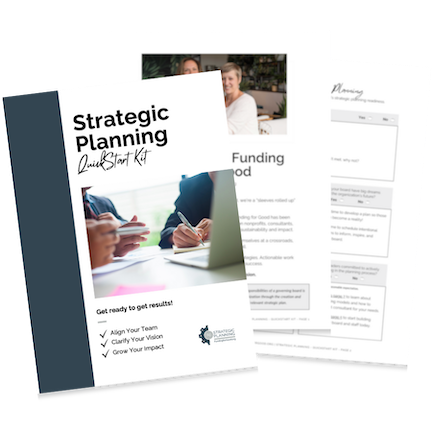One frequent question we hear from organizations is: What are the steps in strategic planning?
Leaders, especially those looking to make do without hiring a strategic planning consultant, imagine there might be a nice simple checklist. Follow the steps one by one and, by the final step, you’ll have a perfect strategic plan.
But while it is possible to break down the different steps in strategic planning—which we do below—there’s much more nuance to the process than a checklist can provide.
Strategic planning is about listening, learning, and aligning. In the end, the biggest benefit of a strategic plan isn’t the written document. It’s how the strategic planning process builds buy-in and alignment among your board, staff, and other key stakeholders. That’s why Funding for Good recommends organizations work with a strategic planning consultant. This frees up leaders to focus on strategy development, rather than getting bogged down in organizing meetings.
Read more: Complete Guide to Hiring and Working with Strategic Planning Consultants
How Many Steps Are in a Strategic Planning Process?
Every consultant, method, and worksheet will have slightly different steps. Online, you can find lists of the five steps in strategic planning or seven steps or even 10 steps! Often, these lists conflate the strategic planning process with the implementation process.
At Funding for Good, we think of strategic planning in two phases: the planning phase and the implementation phase. The planning phase should include at least three steps, with different activities and outcomes covered under each.
Step One: Lay the groundwork for your process and strategy
Before jumping straight into a strategic planning session, you need to prepare. This will save time and money in the long run. You’ll want to focus on two areas:
- Logistics: You and your consulting team, if you have one, should align on the work plan, timeline, roles, expectations, and deliverables. You’ll also need to determine who will participate in your strategic planning retreat or other similar sessions. You should already have determined how long your strategic plan will cover by this point. Generally, strategic plans cover a 3–5-year period. Though some organizations seek longer time horizons, such as 10 years, there are pros and cons to consider.
- Setting strategy baseline: Here, you and your consultants will focus on gathering the information and resources to understand where your organization is today and what challenges lie ahead. This includes collecting stakeholder input, conducting an organizational assessment, and revisiting your vision and mission statements to ensure they still accurately reflect your organization’s work.
Step Two: Hold a strategic planning retreat
With your groundwork laid—and plenty of insights into your organization’s current status—it’s time to dig into your strategic planning sessions. At Funding for Good, we usually recommend holding a strategic planning retreat to get your board and staff leadership team away from day-to-day workplace responsibilities and into a more creative mindset. However, some organizations prefer to hold a series of shorter planning sessions rather than one longer retreat.
Regardless of the format, this is where the real consensus-building work happens. With your board and staff leadership, along with any other stakeholders you’ve decided to include, you’ll develop and align around a shared vision for your organization’s future. This will flow into creating goals, strategies, and measures of success for the next 3-5 years.
Read more: Strategic Planning: What to Expect When Selecting a Facilitator
Step Three: Write your strategic plan
The final planning stage is putting the shared vision you’ve created into writing. If you have a consultant, you’ll work closely together as they prepare and finalize your written strategic plan. You’ll also want to be proactive about building internal awareness, alignment, and buy-in across your organization. Your consultant can help you develop and implement a thoughtful rollout strategy.
Moving Into Strategic Plan Implementation
Once your strategic plan is written and approved by both board and staff leadership, you might feel like celebrating. But in truth, the work is just getting started.
Step Four: Develop implementation plans
A strategic plan is a roadmap to achieve your organization’s vision, but you still need to create your step-by-step guide for arriving at your destination. Here at Funding for Good, we call these implementation and action plans. If your organization is large, you may need to create implementation plans for each department. If you’re a nonprofit, you’ll also likely need a fundraising plan.
Read more: What is an Operational Plan vs a Strategic Plan?
Step Five: Implement, review, revise
Finally, it’s critical to treat your strategic plan like a living document. That means reviewing it regularly (we recommend quarterly) to assess progress and determine any revisions, updates, or lessons learned you may want to integrate into your plan. If your implementation changes course significantly, it may be time to revisit your strategic plan as a whole to ensure it stays timely and relevant.
Read more: How Often Should an Organization Revise its Strategic Plan?



